Click on images to enlarge
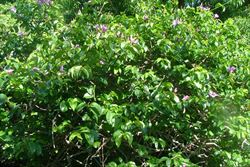
habit (Photo: Sheldon Navie)
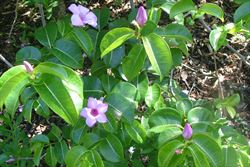
habit (Photo: Sheldon Navie)
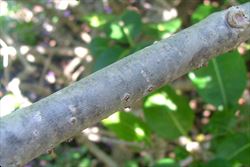
older stem (Photo: Sheldon Navie)

younger stem and leaf bases (Photo: Sheldon Navie)
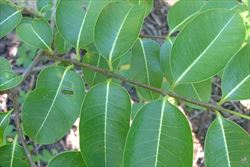
leathery leaves (Photo: Sheldon Navie)

flower buds (Photo: Sheldon Navie)
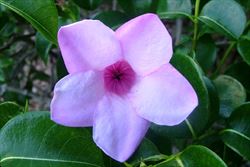
close-up of flower (Photo: Sheldon Navie)

immature fruit in a divergent pair (Photo: Sheldon Navie)
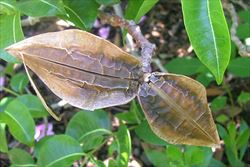
mature fruit (Photo: Sheldon Navie)

old fruit with seeds (Photo: Sheldon Navie)
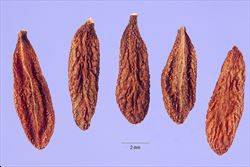
close-up of seeds with hairs removed (Photo: Steve Hurst at USDA PLANTS Database)
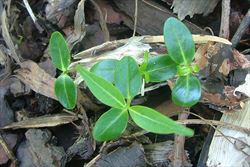
seedlings (Photo: Sheldon Navie)
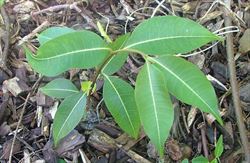
young plant (Photo: Sheldon Navie)
Scientific Name
Cryptostegia madagascariensis Bojer ex Decne.
Synonyms
Cryptostegia madagascariensis Bojer ex Decne. var. glaberrima (Hochr.) J. Marohasy & P.I. Forst.Cryptostegia madagascariensis Bojer ex Decne. var. madagascariensis
Family
Asclepiadaceae (the ACT, Victoria, Tasmania, South Australia, Western Australia and the Northern Territory)Apocynaceae (Queensland and New South Wales)
Common Names
Madagascar rubber vine, Madagascar rubbervine, ornamental rubber vine, purple allamanda, purple rubber vine, rubber vine, rubbervine
Origin
Native to north-western Madagascar.
Cultivation
This species is commonly grown as a garden ornamental in the northern parts of Australia.
Naturalised Distribution
This species is not yet widely naturalised in Australia. It currently has a scattered distribution in the northern parts of Western Australia (particularly around the town of Broome) and the Northern Territory, and is also sparingly naturalised in south-eastern Queensland.
Naturalised overseas in south-eastern USA (i.e. Florida), Puerto Rico and Hawaii.
Note: Three varieties of this species are sometimes recognised, and two of these are known to be naturalised in Australia. Most of the naturalised populations are Cryptostegia madagascariensis var. glaberrima, however Cryptostegia madagascariensis var. madagascariensis has been recorded in the northern parts of the Northern Territory.
Habitat
A weed of tropical, sub-tropical and semi-arid environments that infests waterways, open forests, rainforests, monsoon vine forests, pastures, roadsides and waste areas.
Habit
Without support this species grows as a multi-branched and upright (i.e. erect) shrub, but when growing over vegetation it grows as a robust and rampant woody climber.
Distinguishing Features
- a robust woody vine or self-supporting shrub with milky sap.
- its stems are greyish-brown and have a prominent, whitish, warty spots.
- its oppositely arranged leaves (2-11 cm long and 1.5-5.5 cm wide) are leathery and borne on greenish-coloured stalks.
- its pink or purplish-pink tubular flowers (3-4 cm long and 5-6 cm across) have five spreading petal lobes.
- its large 'pods' (5-9 cm long and 1.5-4 cm wide) are produced in divergent pairs and contain numerous seeds.
- the seeds (5.5-9 mm long and 1.8-3.5 mm wide) are topped with a silky tuft of white hairs (10-35 mm long).
Stems and Leaves
The stems contain a milky sap (i.e. latex) and are grey or greyish-brown in colour. They have a covering of prominent warty spots (i.e. lenticels) and the younger branchlets may be hairless (i.e. glabrous) or finely hairy (i.e. pubescent).
The leaves are thick and leathery in nature and are oppositely arranged along the stems. These leaves (2-11 cm long and 1.5-5.5 cm wide) have dark green and glossy upper surfaces and duller undersides that may be slightly hairy (particularly along the veins). They are oval (i.e. elliptic) or egg-shaped in outline (i.e. ovate), or rarely almost round (i.e. sub-orbicular), and are borne on greenish-coloured stalks (i.e. petioles) 4-17 mm long.
Flowers and Fruit
The pink or purplish-pink coloured flowers are relatively large and showy (3-4 cm long and 5-6 cm across). They are funnel-shaped (i.e. tubular) and have five broad, pointed, petal lobes (i.e. corolla lobes). These flowers are borne on short stalks (i.e. pedicels) 3-8 mm long and are arranged in small clusters at the ends of the branches. Flowering occurs mainly during summer.
The fruit resemble pods (they are actually follicles) and are produced in divergent pairs. These fruit (5-9 cm long and 1.5-4 cm wide) turn from green to brown and split open when mature. They contain numerous seeds (5.5-9 mm long and 1.8-3.5 mm wide) that are topped with a silky tuft of white hairs (i.e. coma) 10-35 mm long.
Reproduction and Dispersal
This plant reproduces by seed, which are mainly dispersed by wind and water. They may also be spread in dumped garden waste.
Environmental Impact
Purple rubber vine (Cryptostegia madagascariensis) is regarded as a potentially significant environmental weed in the Northern Territory, Western Australia and Queensland. It was recently listed as a priority environmental weed in one Natural Resource Management region. It is thought that this species poses a similar invasive threat to rubber vine (Cryptostegia grandiflora), and it has already become naturalised in natural communities in northern Australia and Hawaii.
Legislation
This species is declared under legislation in the following states and territories:
- Northern Territory: A - to be eradicated (throughout all of the Territory), and C - not to be introduced into the Territory.
- Queensland: Class 3 - this species is primarily an environmental weed and a pest control notice may be issued for land that is, or is adjacent to, an environmentally significant area (throughout the entire state). It is also illegal to sell a declared plant or its seed in this state.
- Western Australia: P1 - trade, sale or movement into the state prevented, and P2 - to be eradicated (throughout the entire state).
Similar Species
Purple rubber vine (Cryptostegia madagascariensis) is very similar to rubber vine (Cryptostegia grandiflora). It is also relatively similar to the garden plant known as purple allamanda (Allamanda blanchetii). These species can be distinguished by the following differences:
- purple rubber vine (Cryptostegia madagascariensis) has oppositely arranged leaves with yellowish-green coloured stalks (i.e. petioles) and midribs. Its younger branches and leaves may sometimes be slightly hairy (i.e. puberulent), its flowers are usually uniformly bright pink or purplish in colour, and its paired fruit are always each less than 10 cm long.
- rubber vine (Cryptostegia grandiflora) has oppositely arranged leaves with slightly reddish or purplish-coloured stalks (i.e. petioles) and midribs. Its younger branches and leaves are always hairless (i.e. glabrous), its flowers are usually pale pink in colour with a much deeper coloured throat, and its paired fruit are commonly each more than 10 cm long.
- purple allamanda (Allamanda blanchetii) has its leaves arranged in whorls of three or more along its stems (i.e. they are verticillate). Its younger stems and leaves are somewhat hairy (i.e. pubescent), its flowers are usually uniformly bright pink or purplish in colour, and its rounded fruit are rarely seen.
Australian rubber vine (Gymnanthera oblonga) also has a similar habit and grows in the same areas of northern Australia. However, it can be easily distinguished by its much smaller greenish-yellow flowers (less than 2 cm long) and narrower fruit (only 5-6 mm wide).

